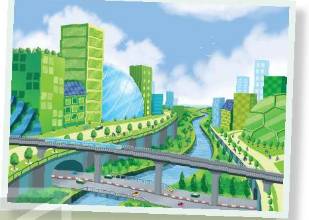Work in groups. Discuss the questions.
1. What will future cities look like?
2. Do you think they will be ‘smarter’ and more sustainable? Why/Why not?

Work in groups. Discuss the questions.
1. What will future cities look like?
2. Do you think they will be ‘smarter’ and more sustainable? Why/Why not?

Read the article. Circle the correct meanings of the highlighted words and phrases.
By 2050 the world’s population is expected to reach 10 billion, and nearly 70 per cent of these people will live in cities. The cities of the future wili be ‘smarter’ and more sustainable to cope with a growing population and improve people’s lives.
A smart city is amodern urban area that uses a range of technologies to provide services, solve problems, and support people better. The new technologies can help save time by predicting changes in the traffic and warning people of possible traffic jams. They will also help cities operate more efficiently. For example, street lights can turn off when the streets are empty, and sensors can inform waste collection teams when the bins are full. These smart technologies will help save energy, reduce air pollution, and fight climate change.
Cities in the future will also be sustainable. They will include a lot of green space and become home to more plants and animals. Making room for biodiversity and nature can be done in various ways including underground and rooftop farming, green roofs, and roof gardens. As people will care more about the environment, most cities will use renewable and clean energy. Modern infrastructure will also be more eco-friendly. Computer-controlled transport systems like electric buses and trains will produce less greenhouse gas emissions. In addition, more pedestrian zones for walking and cycle paths will be made available for people in all neighbourhoods.
These features will make future cities more liveable and will provide a high quality of life to city dwellers.
1. operate more efficiently
A. to work better without wasting time, money, or energy
B. to control a machine without wasting resources
C. to cut a body open for medical reasons in a more careful way
2. sensors
A. devices that can react to light, heat, or pressure
B. instruments that can be played by people
C. devices for discovering rubbish
3. pedestrian zones
A. areas for cars only
B. areas for electric buses
C. areas for walking only
4. liveable
A. suitable for farming
B. nice to live in
C. good for the environment
Read the article again and decide whether the statements are true (T) or false (F).
| T | F |
1. About 70 million people will live in cities by 2050. |
|
|
2. Smart cities use modern technologies to save time and provide better services. |
|
|
3. City dwellers will be able to grow vegetables underground or in roof gardens. |
|
|
4. Space for walking and cycling will be replaced with computer-controlled transport systems. |
|
|
Read the article again and complete the diagram with information from the text. Use no more than TWO words for each answer.

Work in groups. Discuss the following questions.
Would you like to live in a smart and sustainable city? Why/Why not?
Yes, I would like to live in a smart and sustainable city because it would provide me with a better quality of life. I believe that the use of modern technologies and eco-friendly infrastructure would make the city more efficient, reduce pollution, and provide more green spaces.
Trả lời bởi Toru
1.
Future cities are likely to be more technologically advanced and densely populated than they are today.
(Các thành phố trong tương lai có thể sẽ có công nghệ tiên tiến hơn và đông dân cư hơn so với hiện nay.)
They may also be more sustainable, with green spaces and renewable energy sources.
(Chúng cũng có thể bền vững hơn, với không gian xanh và các nguồn năng lượng có thể tái tạo.)
There may be a greater focus on public transportation and walkability, rather than car-centric design.
(Có thể có sự tập trung nhiều hơn vào giao thông công cộng và khả năng đi bộ hơn là thiết kế tập trung vào ô tô.)
2.
Yes, I think future cities will be smarter and more sustainable.
(Vâng, tôi nghĩ các thành phố trong tương lai sẽ thông minh hơn và bền vững hơn.)
Technology will play a key role in optimizing resource usage, reducing waste, and improving efficiency.
(Công nghệ sẽ đóng một vai trò quan trọng trong việc tối ưu hóa việc sử dụng tài nguyên, giảm lãng phí và nâng cao hiệu quả.)
There is also a growing awareness of the need to reduce our impact on the environment, and sustainability will be a key consideration in urban planning and development.
(Ngoài ra còn có nhận thức ngày càng tăng về nhu cầu giảm tác động của chúng ta đối với môi trường và tính bền vững sẽ là yếu tố chính được xem xét trong quy hoạch và phát triển đô thị.)
Trả lời bởi Quoc Tran Anh Le